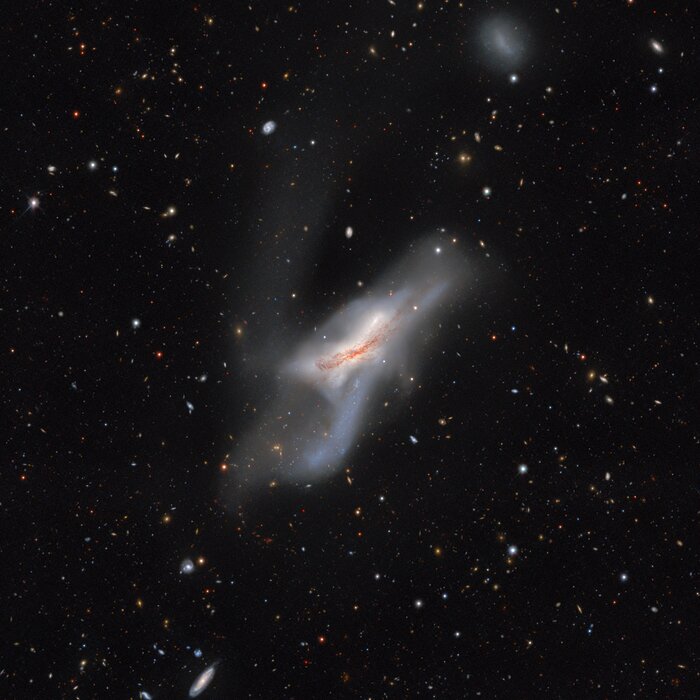The Milky Way is just one galaxy in a vast cosmic web that makes up the Universe’s large-scale structure. While ESA’s Gaia spacecraft is building a map of our stellar neighborhood, a team of astronomers with the Dark Energy Spectroscopic Instrument (DESI) Legacy Survey have released a comprehensive galactic map that includes all the data from three wide-ranging surveys completed between 2014 and 2017. Called the Siena Galaxy Atlas (SGA), it contains the distance, location, and chemical profile of 380,000 galaxies across half of the night sky.
“Previous galaxy compilations have been plagued by incorrect positions, sizes and shapes of galaxies, and also contained entries which were not galaxies but stars or artifacts,” explained Arjun Dey, an astronomer with NOIRLab, who was involved in the project. “The SGA cleans all this up for a large part of the sky. It also provides the best brightness measurements for galaxies, something we have not reliably had before for a sample of this size.”
NOIRLab is the US National Science Foundation’s National Optical-Infrared Astronomy Research Laboratory, which coordinated the project. The SGA is named for Siena College in Loudenville, New York.
Astronomers say this map of the sky helps provide a comprehensive picture of the cosmos as well as providing support further research, including studies of galaxy formation and the structure of the Universe. Comprehensive all-sky surveys can help scientists spot broad patterns across a population of objects, put new discoveries such as transient events in the context of their surroundings, and identify the best candidates for focused observations.
Data for the SGA comes from the Dark Energy Camera (DECam) on the Víctor M. Blanco 4-meter Telescope at CTIO in Chile; the Mosaic3 camera on the Nicholas U. Mayall 4-meter Telescope at Kitt Peak National Observatory in Arizona; and the Beijing-Arizona Sky Survey (BASS) with the 90Prime camera on the Bok 2.3-meter Telescope, which is operated by Steward Observatory at KPNO. It also contains additional data from a survey by NASA’s Wide-field Infrared Survey Explorer (WISE) satellite.
 A galactic collision of two galaxies which began more than 300 million years ago, NGC 520 is actually made up of two disk galaxies which will eventually merge together to form one larger, more massive system. NGC 520 was discovered by William Herschel in 1784 and is one of the largest and brightest galaxies in the Siena Galaxy Atlas. Credit:CTIO/NOIRLab/DOE/NSF/AURA
A galactic collision of two galaxies which began more than 300 million years ago, NGC 520 is actually made up of two disk galaxies which will eventually merge together to form one larger, more massive system. NGC 520 was discovered by William Herschel in 1784 and is one of the largest and brightest galaxies in the Siena Galaxy Atlas. Credit:CTIO/NOIRLab/DOE/NSF/AURANOIRLab said all these surveys captured images in optical and infrared wavelengths to chart a total area of 20,000 square degrees — which comprises nearly half of the night sky — making it among the largest galaxy surveys. With all this information brought together in one place, the SGA offers precise data on the locations, shapes, and sizes of hundreds of thousands relatively nearby large galaxies. It also updates old data with unprecedented accuracy. It is also the first comprehensive survey to provide data on the galaxies’ light profiles.
“Nearby large galaxies are important because we can study them in more detail than any other galaxies in the Universe; they are our cosmic neighbors,” said John Moustakas, professor of physics at Siena College and SGA project leader, in a press release. “Not only are they strikingly beautiful, but they also hold the key to understanding how galaxies form and evolve, including our very own Milky Way galaxy.”
The SGA is not only available to professional astronomers, but is also completely available to the public to peruse and use.
Panning on galaxies NGC 520 and IC 4212, both from the Siena Galaxy Atlas.“The SGA is going to be the pre-eminent digital galaxy atlas for large galaxies,” says Dey. However, he points out that the SGA is not just for academic researchers, it is freely available to view online for anyone wishing to get to know our corner of the Universe better. Dey adds, “In addition to its scientific utility, it has a lot of pictures of beautiful galaxies!”
“The public release of these spectacular data contained in the atlas will have a real impact not only on astronomical research, but also on the public’s ability to view and identify relatively nearby galaxies,” says Chris Davis, NSF Program Director for NOIRLab. “Dedicated amateur astronomers will particularly love this as a go-to resource for learning more about some of the celestial targets they observe.”

